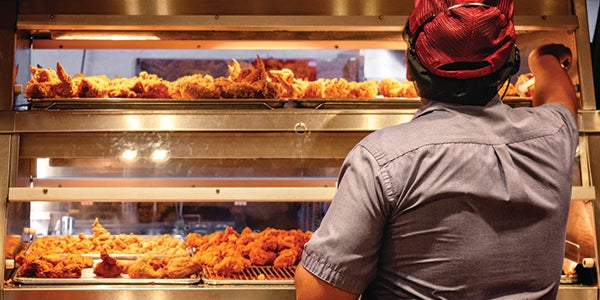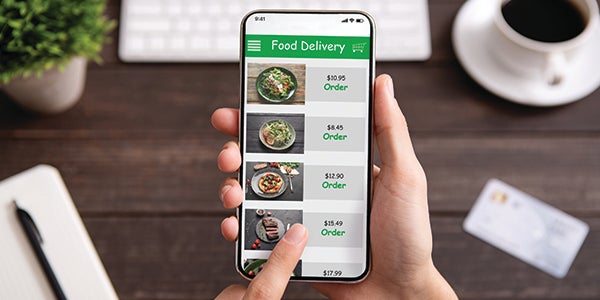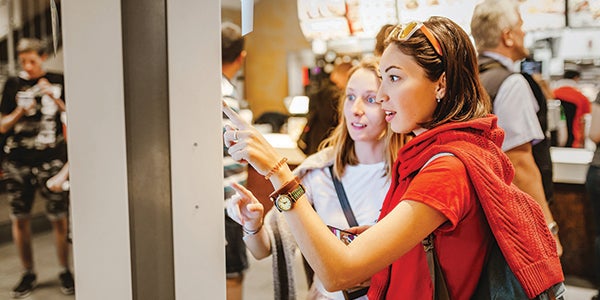As the global economy enters a post-Covid age, rising inflation rates have QSR franchisees on edge. As unpredictable labor shortages and supply chain bottlenecks abound, QSR franchisees need to rely on the wisdom of their most trusted financial partners to weather the storm. Find out what realistic business strategies QSR franchisees can employ to combat rising inflation, labor shortages, and shipping costs in a highly competitive food service market.
Keeping business strategies current is vital to survival today more than ever. The modern age champions rapid convenience at the lowest price-point possible, so it's no wonder quick-service restaurants (QSRs) dominate the American foodservice industry.
More commonly referred to as “fast food restaurants,” QSRs represent over 80% of limited-service industry sales. Furthermore, they boast over 350,000 locations in the US just a few years ago. Business strategies dating back to the first Golden Arches have transformed the industry, leading to QSRs cropping up in every corner of the world. However, as the global economy enters a post-Covid age, rising inflation rates have QSR franchisees on edge.
As unpredictable labor shortages and supply chain bottlenecks abound, QSR franchisees need to lean on the expertise of their most trusted financial partners to help weather the storm. Furthermore, the rise of fast-casual restaurants like Chipotle and Panera Bread present competitive challenges for legacy QSRs like McDonald's, Burger King, and Taco Bell.
What realistic business strategies can QSR franchisees employ to combat rising inflation, labor shortages, and shipping costs in a highly competitive foodservice market?
The Impact of Inflation on the QSR Industry
It's no secret that rising inflation forced many QSR businesses to implement belt-tightening strategies like cutting costs or raising prices. The economy showed blossoming signs of life as Covid vaccines became widely available. However, with those vaccines simply came new challenges, as we shifted into a new phase of pandemic. Now, with inflation predicted to reach as high as 10% in 2022, QSRs are turning to alternative measures to combat rising costs.

Instead of downsizing product, McDonald's and Taco Bell chose instead to increase prices. For years, McDonald's boasted a $1 any-size drink promotion. According to the Wall Street Journal, some franchisees are now raising prices on their drinks. Between July 2020 and July 2021, Taco Bell also raised prices on staple menu items by 10%.
However, price hikes and portion downsizing could backfire, as inflation limits the average American’s spending capacity. Such practices could turn them off from established franchises, in search of more value. What sort of business strategies can QSR franchisees implement to attract more customers without raising prices?
Business Strategies to Help QSR Franchisees Weather the Storm
Loyal customers notice when they're spending more at the drive-thru window and they can tell when they aren't getting as many chicken nuggets or french fries as they used to. Many withheld frustration, understanding Covid-19’s impact on QSRs. Those same customers may find themselves less forgiving as we enter the post-Covid world. Thankfully, there are a number of business strategies QSR franchisees can employ to circumvent blatant price hikes and size reduction while still combating inflation.
To start, QSR franchisees should utilize advanced data analytics to understand trends within their customer base. Furthermore, advancing technology makes food delivery and ordering apps crucial for reaching customers in their homes. Rather than relying on them to visit the store, meet customers where they are—literally.
Many QSR chains are also restructuring their menus to cut back on food costs, while simultaneously enhancing the customer experience with seasonal offerings. With the help of a trusted financial partner, franchisees can implement the following strategies to ride out this inflationary period.
Data Analytics Can Help QSRs Better Understand Their Customers
Data analytics has become an integral component of any successful business in the information age. With so many digital transitions occurring every minute of every day, QSRs can utilize data to track and study trends in their consumer base.
According to findings from the Boston Consulting Group, better analytics can increase revenues by 10%, while reducing operating costs by upwards of 15%. With such staggering improvements, it's incredible that a third of American restaurants lag behind adopting new data-capture technologies.
Full-scale data analytics on a corporate level presents nuanced challenges, given the complex nature of franchises. However, franchisees with a handful of establishments under their control can utilize these findings, packaging them into actionable business strategies for their restaurants. From consumer data to sales numbers to the menu itself, you can mine your first-party data and turn insights into strategic actions.

Menu Data and Analytics
The menu itself is ripe with data. Franchisees should analyze the most popular and profitable items, evaluating each by several visual and financial metrics. For example, text, layout, and appearance play a significant role in customer choice. Just because a particular menu item sells well doesn't mean customers like it the most by traditional standards of flavor and value.
Research from Cornell University found that menu items highlighted with bold and colored text attract more shoppers. Furthermore, items placed in their own boxes, separate from other options, were more likely to be purchased. Even bolstering the item description with a few attractive adjectives can drive sales.
This same Cornell research finds that removing dollar signs from the menu increased consumer spending by 8%. While that figure aimed more towards "upscale casual" dining, one can apply the same sociological principle to QSRs.
Consumer Analytics
Breaking down your customer base into segmented groups can open the floodgates of consumer data. Understanding why they come to the restaurant, what they order, and when paints a picture of customer habits.
Do they come for a snack? A full meal? Perhaps they only pop in for a cup of coffee and never order anything else? Based on understanding the buying behaviors of various customer segments, franchisees can implement different menu options and deals at specific times of the day.
For example, if certain menu items are only available at specific times of day can increase the item's profitability during that window, while reducing inventory costs. Since the restaurant only sells that product at lunchtime, it doesn't have to account for all-day demand. Thus, the focus can be on only preparing what’s needed to get through the lunch window.
Franchisees can also analyze demographics such as age, gender, marital status, income, and preferred payment methods. Such information can help tailor marketing strategies, loyalty campaigns, and recommendations towards the local demographic.
Sales Data
Tracking sales analytics year-over-year remains one of the most prudent business strategies for every QSR franchisee. Historical sales trends can account for seasonal variance, thus accurately predicting trends throughout the year. These metrics are crucial to inventory management and can reduce operating costs by simply avoiding waste.
Sales analytics also identify the busiest times of day for staffing, allowing managers to schedule more staff to handle the influx of customers. Furthermore, managers know when to plan staff changeover, as a shift change during the lunch rush will negatively disrupt the flow of business.
QSRs Should Continue Riding the Wave of Food Delivery Apps

Despite all the financial headaches brought upon by the Covid-19 pandemic, QSRs did manage to find a silver lining. As it turns out, they were naturally equipped to handle pandemic restrictions, as drive-through windows, take-out options, and non-contact delivery made pandemic operations more manageable.
Statistics from the American Journal of Transportation show just how much the food delivery industry blossomed between 2020 and 2021. The global market revenue jumped up 27% year-over-year, topping out at $136 billion in 2020. It's believed those numbers could reach $182 billion by 2024. Mobile ordering, even before the pandemic, trended upward. Now, it's one of the best business strategies any QSR can implement to drive sales in the face of rising inflation.
Mobile ordering can curb bottlenecks in drive-through lanes and the kitchen alike. Now, instead of 20 customers arriving and ordering simultaneously, you have 10 placing orders online and 10 going through the drive-up window. Staff can fulfill mobile orders in advance without delaying the entire operation.
Mobile Ordering Options
QSRs have two channel options when it comes to mobile ordering. On the one hand, you have services like GrubHub, Uber Eats, and the industry-leading DoorDash. These food aggregators act as middlemen, connecting customers to your restaurant. They utilize mobile apps to streamline the ordering process from the comfort and safety of home. However, they also come with various fees and commissions that dig into a restaurant's already thin profit margin.
On the other hand, you have franchise-specific mobile apps, like the McDonald's or Starbucks apps, that allow customers to order directly, without the added cost of food delivery. While aggregated food delivery apps restrict branding and personalization, franchise mobile apps is simply the online front door to your QSR.
There's no denying the technology gap between QSRs and software development companies. To bridge those gaps, software companies work with QSRs to build the best apps for to meet your business and customer’s buying needs. A trusted financial partner can help franchisees determine how to navigate the investment required to partner with a software developer to build a custom app.
Thankfully, QSR franchisees don't have to choose between dedicated apps and listing their business on meal aggregators. The most successful business strategies embrace both. Franchisees can utilize meal aggregators like DoorDash and GrubHub to attract new customers. Then, they can retain those customers with dedicated apps. Loyalty programs, deals, and menu customization are just a few ways in which dedicated apps can turn new customers into loyal followers.
Transforming Menus to Meet Changing Tastes
At the onset of Covid-19, QSR franchises tested out a whole host of new ideas to maintain profits as best they could. Among those strategies was menu trimming, and those "leaner" menus might be here to stay.
It makes sense: smaller menus make it easier to train new staff, maintain inventory, and reduce overall waste. According to Tom Cook of King-Casey, customers were more concerned about convenience than menu variety during the Covid era. Continuation of that trend appears imminent.
Gary Stibel, founder and CEO of New England Consulting Group, believes oversized menus are an infectious disease in their own regard. According to Stibel, a 10-15% reduction in menu size can benefit the bottom line while doing minimal damage to customer sentiment. In short, finding the perfect balance between variety and inventory management is essential. Too much variety can have several adverse effects, as customers may experience decision paralysis. They may end up ordering something cheap, something they don't want, or the first thing they see to avoid reading the whole menu.

Item rotation and seasonal additions can also entice new customers. Of course, it's imperative to balance rotating menu items with promoting the staples that keep customers coming back. Here's where data analytics comes full circle—franchisees can tell which menu items to keep and which to move to a seasonal rotation.
Communication between franchisees plays an important role in new item creation and marketing. While corporate R&D focuses on the big picture, franchisees understand their home market better than anyone. They can bounce ideas off neighboring markets and review data to see what's working and what needs improvement.
Business Strategies to Inflation-Proof Your QSR Today
Inflation is projected to prove a daunting obstacle for businesses in 2022, and QSR franchisees are no exception. With business strategies centered around data analytics, mobile access, and menu optimization, those operators can be better prepared to weather the inflation storm.
Investing in data analytics, mobile ordering, and managing seasonal menu offerings can be complex to financially navigate. Get in touch with Dubuque Bank & Trust, a division of HTLF Bank today to speak with a commercial banker with deep QSR industry knowledge. They can help you prepare your business for the coming year—and better safeguard against future dips in your bottom line as well.









